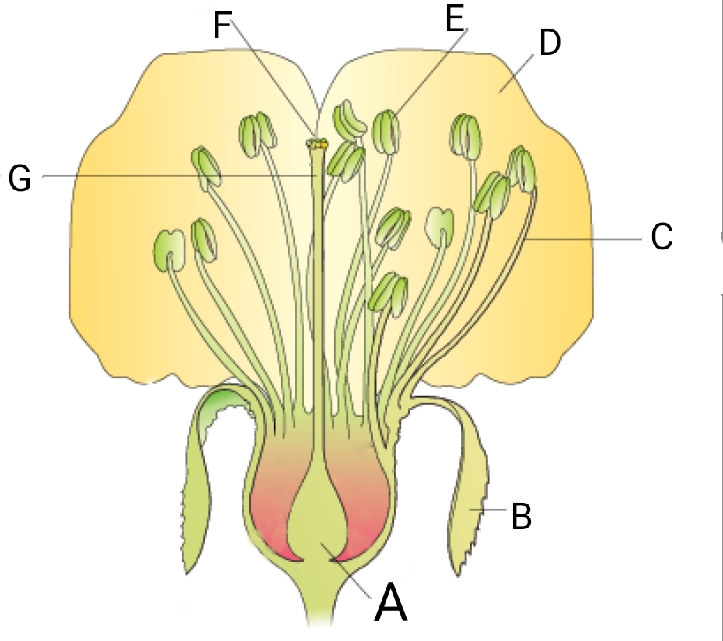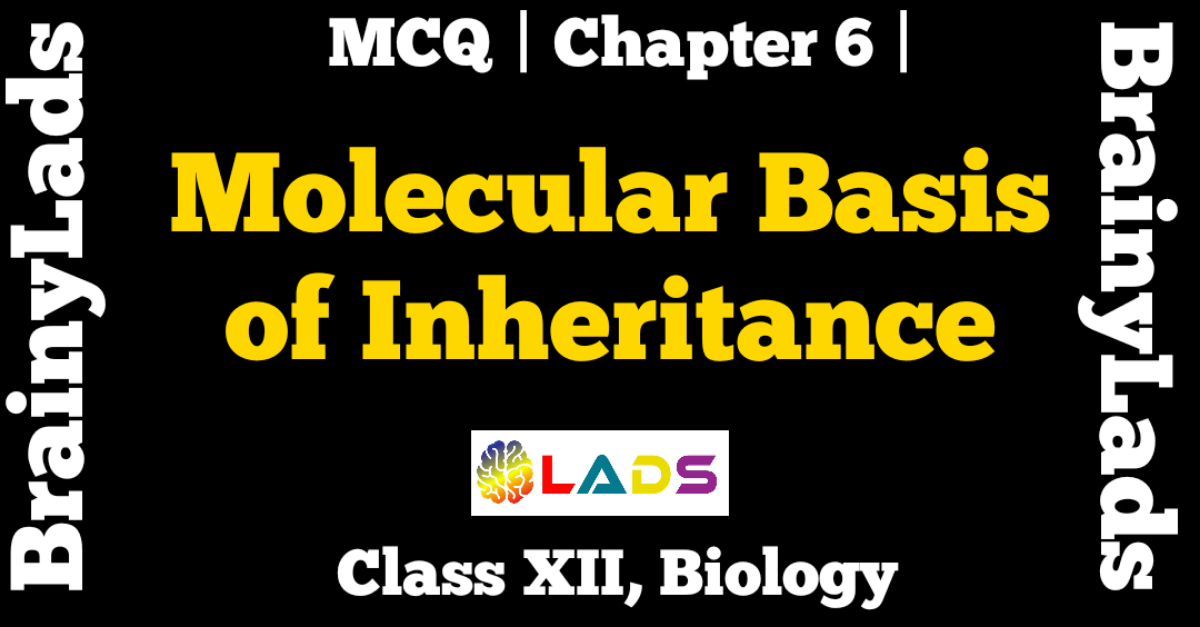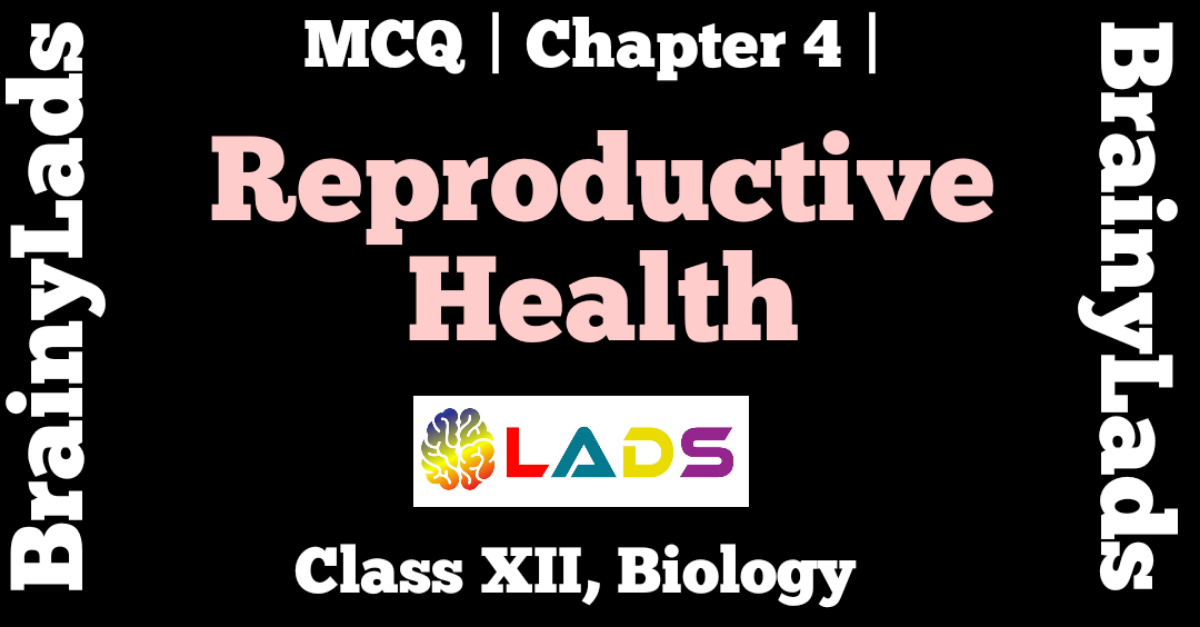MCQ Of Sexual Reproduction in Flowering Plants | Chapter 2 |Class 12 |
MCQ of Sexual Reproduction in Flowering Plants, Chapter 2, Class 12 Biology
Question 1: Identify A to G in following figure and answer accordingly.
- A – Ovary , B – Filament , C – sepal , D – Petal , E – Style , F – Stigma , G – Anther
- A – Sepal , B – Ovary , C – Petal , D – Filament , E – Anther , F – Stigma , G – Style
- A – Ovary , B – Sepal , C – Filament , D – Petal , E – Anther , F – Stigma , G – Style
- A – Petal , B – Anther , C – Stigma , D – Style , E – Filament , F – Sepal , G – Ovary
Answer : C (A – Ovary , B – Sepal , C – Filament , D – Petal , E – Anther , F – Stigma , G – Style)
Question 2: The Terminal structure of stamen is called
- Pollen
- Filament
- Anther
- All of these
Answer : C (Anther)
Question 3: Male gametophyte in angiosperms produces
- Two sperms and a vegetative cell
- Single sperm and a vegetative cell
- Single sperm and two vegetative cell
- Three sperms
Answer : A (Two sperms and a vegetative cell)
Question 4: The lengthwise running groove on and anther which separate theca is called
- Rupture line
- Line of dehiscence
- Suture of Anther
- None of these
Answer : B (Line of dehiscence)
Question 5: Number of microsporangia in angiosperm anther is
- 1
- 2
- 3
- 4
Answer : D (4)
Question 6: Microsporangium develops into
- Pollens
- Microgamates
- Megagamates
- Pollen sac
Answer : D (Pollen sac)
Question 7: The innermost layer of microsporangium is
- Tapetum
- Endothecium
- Middle layer
- Epidermis
Answer : A (Tapetum)
Question 8: Centre of each microsporangium is occupied by
- Sporogenous tissue
- Tapetum
- Central tissue
- Microspore mother cell
Answer : A (Sporogenous tissue)
Question 9: Which of the following perform microsporogenesis?
- Microspore mother cell
- Pollen mother cell
- Both A and B
- None of the above
Answer : C (Both A and B)
Question 10: Microspore tetrad (pollen grains)is a result of
- Mitotic cell division
- Meiotic cell division
- Both A and B
- None of these
Answer : B (Meiotic cell division)
Question 11: The above diagram is enlarged view of one microsporangium of a mature anther identify A , B , C –
- A – Middle layer , B – Endothecium , C – Tapetum
- A – Endothecium , B – Tapetum , C – Middle layer
- A – Endothecium , B – Middle layer , C – Tapetum
- A – Tapetum , B – Middle layer , C – Endothecium
Answer : C (A – Endothecium , B – Middle layer , C – Tapetum)
You may also read MCQ of Reproduction in Organisms, MCQ of Human Reproduction, MCQ of Reproductive Health, MCQ Of Principles of Inheritance and Variation, MCQ of Molecular Basis of Inheritance for better understanding of the chapters.
Question 12: The proximal part of filaments of stamen is attached to
- Thalamus or the petal
- Sepals or thalamus
- Pedicle aur petiole
- Ovary or Ovule
Answer : A (Thalamus or the petal)
Question 13: Pollens have two prominant walls which are A and B here A and B refers to
- A – Intine B – Protein coat
- A – Exine B – Intine
- A – Sporopollenin B – Intine
- A – Sporopollenin B – Exine
Answer : B (A – Exine B – Intine)
Question 14: The sporopollenin is known degradable because
- It can withstand strong acids
- It is resistant at very high temperature
- No enzyme degrade it
- All of the above
Answer : D (All of the above)
Question 15: Intine is made up of
- Cellulose
- Pectin
- Both A and B
- Protein
Answer : C (Both A and B)
Question 16: Which cell is bigger and have abundant food reserve material during microsporogenesis?
- Generative cell
- Vegetative cell
- Vacuole
- Spore mother cell
Answer: B (Vegetative cell)
Question 17: 60% of the angiosperms shed their pollens at the
- 2 – celled stage
- 3 – celled stage
- 4 – celled stage
- 1- celled stage
Answer: A (2 – celled stage)
Question 18: Function of filiform apparatus is to
- Recognise the suitable Pollen at stigma
- Stimulate division of generative cell
- Produce nectar
- Guide the entry of pollen tube
Answer : D (Guide the entry of pollen tube)
Question 19: Pollens are stored at which temperature
- -196°C
- 196°C
- 10°C
- 0°C
Question 20: The stalk which joins ovule and placenta is called
- Funicle
- Helium
- Chalaza
- Micropyle
Answer : A (Funicle)
Question 21: Embryo sac is also called
- Female gamete
- Synergids
- Female gametophyte
- Egg of angiosperm
Answer : C (Female gametophyte)
Question 22: Megasporogenesis is
- Formation of root
- Formation of seeds
- Formation of megaspore
- Both B and C
Answer : C (Formation of megaspore)
Question 23: Each cell of sporogenous tissue in anther is
- Microspore
- Pollen
- Potential Pollen or microspore mother cell
- Megaspore mother cell
Answer : C (Potential pollen or microspore mother cell)
Question 24: As the anther mature and dehydrate the ____ separate dissociate from each other and develop into ______
- Megaspore , embryo sac
- Microspore , pollen grains
- Pollen grain , megaspore
- Megaspore , microspore
Answer : B (Microspore , pollen grains)
Question 25: Identify A to F in the diagram.
- A – Egg , B – Filiform apparatus , C – Synergid , D – Antipodal cell , E – Polar nuclei , F – Central cell
- A – Egg , B – Synergid , C – Filiform apparatus , D – Antipodal cell , E – Central cell , F – Polar nuclei
- A – Central cell , B – Synergid , C – Synergid , D – Antipodal cell , E – Filiform apparatus , F – Polar nuclei
- A – Filiform apparatus , B – Synergid , C – Egg , D – Central cell , E – Polar nuclei , F – Antipodal cell
Answer : D (A – Filiform apparatus , B – Synergid , C – Egg , D – Central cell , E – Polar nuclei , F – Antipodal cell)
Question 26: Two nuclei with one cell are found in
- Antipodal cell
- Chalazal cell
- Central cell
- Synergid cell
Answer : C (Central cell)
Question 27: Transfer of pollen grains from the anther to stigma of another flower of different plant is called
- Geitonogamy
- Xenogamy
- Chasmogamy
- Cleistogamy
Answer : B (Xenogamy)
Question 28: In Chasmogamy , pollination takes place in
- Open flower
- Close flower
- Large flower
- Geitonogamy flower
Answer : A (Open flower)
Question 29: The most common abiotic pollinating agency in flowering plant is
- Water
- Wind
- Both A and B
- None of these
Answer : B (Wind)
Question 30: Advantage of cleistogamy is
- Higher genetic variability
- More vigorous of offspring
- No dependence on pollinators
- Vivipary
Answer : C (No dependence on pollinators)
Question 31: Characteristics of wind pollinated pollens is , they are
- Non – sticky
- Light
- Large number in production
- All of the above
Answer : D (All of the above)
Question 32: Continued self pollination results in
- Inbreeding depression
- Outbreeding depression
- Hybrid vigour
- Better result in offsprings
Answer : A (Inbreeding depression)
Question 33: Unisexual or dioecious condition prevents
- Autogamy
- Geitonogamy
- Self fertilization
- All of these
Answer : D (All of these)
Question 34: Fertilization involving carrying of male gamate by pollen tube is
- Porogamy
- Siphonogamy
- Chalazagamy
- Synganogamy
Answer : B (Siphonogamy)
Question 35: Geitonogamy involves
- Fertilization of a flower by the Pollen from another flower of the same plant
- Fertilization of a flower by the Pollen from the same flower
- Fertilization of a flower by the Pollen from a flower of another plant in the same population
- Fertilization of a flower by the Pollen from a flower of another plant belonging to a distant population
Answer : A (Fertilization of a flower by the pollen from another flower of the same plant)
Question 36: Polar nuclei are located in
- Pollen tube
- Embryo sac
- Ovule
- Thalamus
Answer : B (Embryo sac)
Question 37: Generally Pollen tube enters through
- Micropylar region
- Antipodal region
- Chalazal end
- Nuclear region
Answer : A (Micropylar region)
Question 38: Number of chromosomes in gamate mother cell is 24, then find out the chromosome number of male and female gamete.
- 18 , 18
- 17 , 18
- 20 , 20
- 12 , 12
Answer : D (12 , 12)
Question 39: PEC (primary endosperm cell) is formed
- After triple fusion
- Before triple fusion
- At the time of syngamy
- Always persisted
Answer : A (After triple fusion)
Question 40: Gametogenesis in haploid plant involves
- Binary fission
- Meiosis
- Mitosis
- Amitosis
Answer : C (Mitosis)
Question 41: In angiosperm , Pollen tube liberate their male gamates into the
- Central cell
- Antipodal cell
- Egg cell
- Synergids
Answer : D (Synergids)
Question 42: Out of the following choose the post fertilization event.
- Endospermogenesis
- Embryogenesis
- Both A and B
- Organogenesis
Answer : C (Both A and B )
Question 43: Which of the following sequence of development of embryo sac is correct?
- Nucellus → megaspore→ embryo sac
- Nucellus → megagametophyte → megaspore → embryo sac
- Nucellus → megasporangium → megaspore → embryo sac
- Nucellus → megaspore mother cell → megaspore → embryo sac
Answer : D (Nucellus→ megaspore mother cell → megaspore → embryo sac)
Question 44: Perisperm is
- Outer part of embryo sac
- Degenerate synergid
- Degenerate secondary nucleus
- Remains of nucellus
Answer : D (Remains of nucellus)
Question 45: Function of suspensor in embryo is
- Absorption of nourishment
- Push the embryo into nuritive endosperm region
- Formation of secondary embryo
- All of the above
Answer : B (Push the embryo into nutritive endosperm region)
Question 46: An ovule has generally how many embryo sac ?
- 1
- 3
- 4
- 8
Answer : A (1)
Question 47: The female gametophyte of dicot or monosporic embryo sac is –
- 7 celled 7 nucleated
- 8 celled 7 nucleus
- 7 celled 8 nucleate
- 8 celled and 7 nucleate
Answer : C (7 – celled and 8 – nucleate)
Question 48: Autogamy is
- Transfer of pollen grains from anther to stigma of the same flower
- Transfer of pollen grains from anther to stigma of the another flower
- Pollination between two flower
- Maturation of anther and stigma at different times
Answer : A (Transfer of pollen grains from anther to stigma of the same flower)
Question 49: Cleistogamous flower produces assured seed set even in the absence of pollinator. why?
- Because they have fragnance
- Because they remain open
- Because they are autogamous
- Because they are colourful
Answer : C (Because they are autogamous)
Question 50: This of the following devices is not used by plants to prevent autogamy –
- Self incompatibility
- Production of unisexual flower
- Heterostyly
- Production of cleistogamous flowers
Answer : D (Production of cleistogamous flowers)
Question 51: Which is not diploid?
- Nucellus
- Integuments
- Endosperm
- Embryo
Answer : C (Endosperm)
Question 52: In dicot embryo the radical is formed by
- Epibasal tier of embryo
- Hypobasal tier of embryo
- Hypophysis of suspensor
- Terminal cell of suspensor
Answer : C (Hypophysis of suspensor)
Question 53: Identify the A to E in following diagram of typical dicot embryo.
- A – Cotyledons , B – Hypocotyle , C – Plumule , D – Root , E – Radicle
- A – Radicle , B – Root cap , C – Plumule , D – Hypocotyle , E – Cotyledons
- A – Hypocotyle , B – Cotyledons , C – Plumule , D – Radicle , E – Root cap
- A – Plumule , B – Cotyledons , C – Hypocotyle , D – Radicle , E – Root cap
Answer : D (A – Plumule , B – Cotyledons , C – Hypocotyle , D – Radicle , E – Root cap)
Question 54: Development of embryo from a cell of embryo sac other than egg is an example of
- Apospory
- Apogamy
- Adventitive embryogeny
- Parthenogenesis
Answer : C ( Adventitive embryogeny)
Question 55: Maturation of stigma and another at different time in the same flower is
- Heterostyle
- Dichogamy
- Dicliny
- Herkogamy
Answer : B (Dichogamy)
Question 56: Movement of pollen tube towards embryo sac is
- Thermotactic
- Phototactic
- Chemotactic
- Thigmotatic
Answer : C (Chemotactic)
Question 57: False fruit is a fruit in which
- Only ovary take part in fruit development
- Only embryo take part in fruit development
- Only chalazal cells take part in fruit development
- Ovary and other floral part included in fruit
Answer : D (Ovary and other floral part included in fruit)
Question 58: Type of cell division takes place in apomixis is
- Reductional
- Meiosis
- Both A and B
- Mitosis
Answer : D (Mitosis)
Question 59: Occurrence of more than one embryo is called
- Polyembryony
- Embryony
- Parthenogenesis
- Fertilization
Answer : A (Polyembryony)
Question 60: Milky water of green coconut is
- Liquid chalaza
- Liquid Nucleus
- Liquid female gametophores
- Liquid endosperm
Answer : D (Liquid endosperm)
Question 61: Germ pore is the area where exine is
- Thick
- Thick and uniform
- Uniform
- Absent
Answer : D (Absent)
Question 62: Pollen kit is formed from
- Endothecium
- Middle layer
- Microspore mother cell
- Tapetum
Answer : D (Tapetum)
Question 63: Remnants of nucellus present in seed are called
- Pericarp
- Periderm
- Endosperm
- Perisperm
Answer : D (Perisperm)
Question 64: A seed is formed from
- Ovule
- Embryo
- Embryo sac
- Ovary
Answer : A (Ovule)
Question 65: Perisperm differ from endosperm in
- Having no reserve food
- Being a diploid tissue
- Its formation by fusion of secondary nucleus with several sperms
- Being a haploid tissue
Answer : B (Being a diploid tissue)
Do share the post if you liked it. For more updates, keep logging on BrainyLads








Great